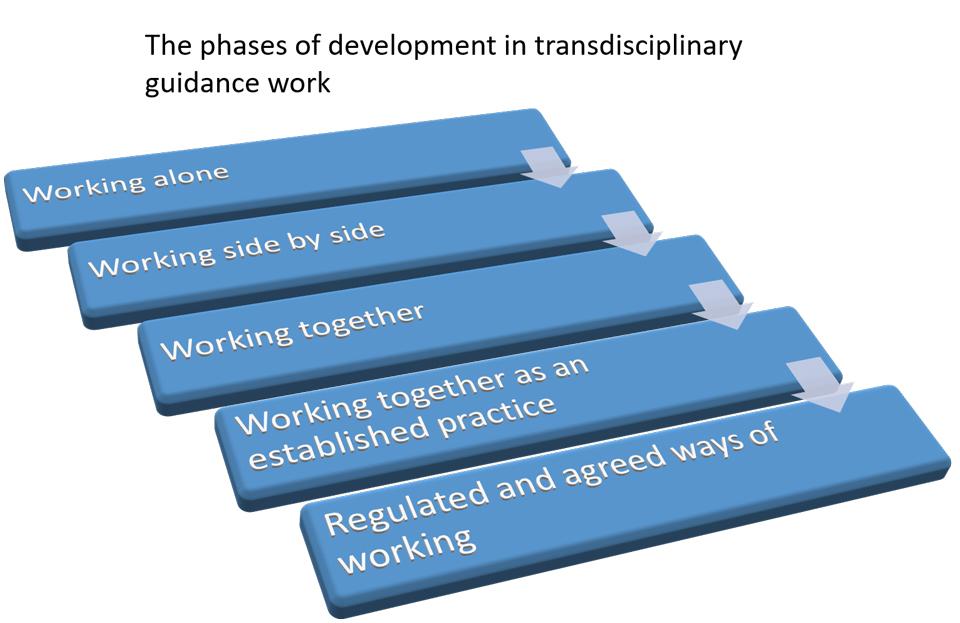
Päivi Pukkila, Taru Lilja, Jaakko Helander & Simo Uusinoka
This article deals with guidance work as transdisciplinary collaboration in Finnish guidance services. The shift from traditional, segmented client work to an inter- or transdisciplinary, low threshold guidance and counselling environment demands acquisition of new skills and ways of working. We examine how transdisciplinary guidance work plays itself out in One-Stop Guidance Centers and present a model which reflects transdisciplinary guidance work as a skill to be developed and learnt. We suggest it is possible to distinguish five developmental stages for transdisciplinary guidance work. Although we are interested in the transdisciplinary guidance and collaboration in One-Stop Guidance Centers, the model can help understand activities and learn transdisciplinary guidance work in any other inter- or transdisciplinary service as well.
What is a One-Stop Guidance Center?
Finland has established a network of One-Stop Guidance Centers, called Ohjaamo in Finnish, in order to strengthen youth services that promote inclusion and transition to employment. The services provide young people under 30 years of age with information, advice and guidance on an easy-access way. The services are client-centred and support the young people until a more long-lasting or permanent solution has been found. This means finding a job, study place or other type of activity.
One-Stop Guidance Centers offer interdisciplinary guidance in many channels, e.g. by appointment, walk-in basis and digitally. In 2019, there are already more than 70 One-Stop Guidance Centers in Finland and the number is still growing. (Euroguidance Finland, 2018)
Transdisciplinary collaboration in One-Stop Guidance Centers
The work community in One-Stop Guidance Centers may be composed of experts in education and training, labour administration or social work and healthcare who represent either public, private or third sector bodies. A One-Stop Guidance Center may operate in one physical location or as a network-based corporation. In line with this is the definition of multidisciplinarity by Nykänen, Risku and Puukari (2017, pp. 309–311), where multidisciplinary collaboration is described as activities that take place both within organisations and between organisations. Collaboration with businesses is also an essential part of the One-Stop Guidance Centers’ operations.
In literature, the concept “multidisciplinary” is commonly used to refer to a collaboration where people from different disciplines work together. However, the definition lacks the aspect of genuine integration of disciplines: merely gathering service providers from several disciplines or organisations to a shared work environment does not automatically make people work together in a cooperative manner. Truly cooperative service is one where the approaches from different disciplines are systematically integrated – sometimes called interdisciplinary. Like Stember (1991) argues, many people believe they work in an interdisciplinary manner, while in fact the approach is multidisciplinary.
In Stember’s (1991) overview of different levels of collaboration between disciplines, she defines interdisciplinarity as integrating knowledge and methods from different disciplines, using a real synthesis of approaches. Transdisciplinary collaboration, on the other hand, goes even further: according to her it is about creating a unity of intellectual frameworks beyond the disciplinary perspectives.
In Finnish, the activities of One-Stop Guidance Centers are described as monialainen yhteistyö (multidisciplinary collaboration) but the concept does not translate directly. With many service providers and different organisations integrated in the One-Stop Guidance Centers, they certainly aspire for inter- or transdisciplinarity. It is also necessary to note that the concepts of multi-, inter- or transprofessionalism and definitions of professional collaboration appear in Finnish research significantly more often than definitions of disciplinary collaboration (Pukkila, Helander, & Laitila, 2015). The term refers to collaboration carried out by representatives of different professions who belong to the same administrative or scientific field (Koskela, 2013).
In this article, we ask whether all One-Stop Guidance Centers are in fact truly trans- or even interdisciplinary. We approach the question by analysing the information gathered during development work in One-Stop Guidance Centers. During the project TESSU – Together for Guidance and Counselling (2015–2019) we studied the activities of One-Stop Guidance Centers through observations, consultations and trainings. The project was directed to support One-Stop Guidance Centers in their transdisciplinary work. Theoretically, our approach makes use of the factors which can promote or prevent transdisciplinary collaboration, identified in previous research.
Factors that promote or prevent transdisciplinary collaboration
Previous research has identified factors which promote or prevent the realisation of transdisciplinary collaboration. The most significant plus factors are a confidential and respectful environment, recognition of the limits of one’s expertise and willingness to move beyond them, and time for shared discussion and reflection. (Hall, 2005; Isoherranen, 2012; Kiilakoski, 2014; Koskela, 2013; Mellin, Hunt, & Nichols, 2011)
The activation of these collaboration-promoting factors requires successful coordination of collaboration activities as well as collaboration and communication skills. In addition, transdisciplinary collaboration requires shared terminology, shared goal formation and continual assessment of these goals.
In order to realise the factors listed above and to acquire a transdisciplinary approach to one’s work, an attitude shift may be required at the level of the individual employee (Hall, 2005; Isoherranen, 2012; Kiilakoski, 2014; Koskela, 2013; Mellin et al., 2011). Transdisciplinary collaboration involves a shift from traditional expert work and established networks to a dynamic combination of independent and communal work.
Factors that inhibit transdisciplinary collaboration include unclear expert roles, imprecise divisions of responsibility, differing communication methods between professional groups and inadequate communication and teamwork skills (Hall, 2005; Holmesland et al., 2010; Isoherranen, 2012; Mellin et al., 2011). In addition, the differing regulations and norms that underlie the activities of different professional groups can make transdisciplinary collaboration more difficult (Kiilakoski, 2014, pp. 72–77). One attitudinal factor that can inhibit collaboration is distrust between different experts, which can be seen in a tendency to defend one’s own territory (Chivers, 2011, p. 11; Kiilakoski, 2014, pp. 86–94).
In addition, factors relating to the practical arrangements of the work, such as a lack of resources or absence of shared physical working spaces, can inhibit the development of genuine transdisciplinary collaboration (Chivers 2011, p. 11; Kiilakoski, 2014, pp. 86–94).
The phases in development in transdisciplinary guidance work
As previous studies indicate, transdisciplinary guidance work can be approached as a skill to be developed and learnt. In our observations in One-Stop Guidance Centers, this is also true. The development process can be seen at different levels and in different stages, and these can be examined from both the individual and community perspective.
Based on our observations, it is possible to distinguish five developmental stages for transdisciplinary guidance work (see Figure 1). In the following section, we describe each developmental stage in more detail and present real-life examples for some stages in the daily operations of the One-Stop Guidance Centers. The examples below in italics have been collected as part of consultations, trainings and observations carried out in One-Stop Guidance Centers. They represent only part of the reality in One-Stop Guidance Centers and are also meant to serve as an invitation to consider the variety of activities in One-Stop Guidance Centers.

1. Working alone. The traditional form of guidance work, in which each counsellor has their own clients and is responsible for these clients’ guidance process.
The municipality has a youth worker, who switches role for several hours each week when working as a One-Stop Guidance Center worker at the youth centre.
2. Working alongside each other. Professionals from the same field or different fields share the same working environment and have sporadic conversations about specific client cases.
3. Working together. The counsellors have shared clients and have agreed on the division of work and how to transfer clients from one counsellor to another.
A client comes to the One-Stop Guidance Center and is assigned an employment coach. The client’s issues involve public employment services and their health situation. The employment coach directs the client to the office of the Public Employment and Business office worker and the public health nurse, whose next available appointment is in two weeks’ time.
4. Working together as an established practice. Joint work between counsellors has become an established and natural way of doing guidance work. Client relationships are shared and guidance work is done which spans different realms of expertise.
A client comes to the One-Stop Guidance Center to get help with making a CV. During the guidance session, it emerges that the client’s job application status needs to be found out. The counsellor consults the Public Employment and Business office worker working in another room and the matter is sorted out immediately.
5. Regulated and agreed ways of operating. Transdisciplinary collaboration is factored in systematically in all activities. The work is based on agreements made and the conscious promotion of transdisciplinary collaboration in the guidance process.
Clients are active participants in their own guidance process, and they are able to influence, for example, the form of support they receive, and the methods used.
Discussion
Our results indicate that transdisciplinary guidance work can be approached as something to develop and this development usually takes place in phases. According to Trodd and Chivers (2011), transdisciplinary collaboration skills are best learnt through practical action – in other words by doing the work itself. One-Stop Guidance Centers are authentic examples of transdisciplinary collaboration in which a transdisciplinary work culture is developed as the work itself is carried out.
It is important to notice that the stages we presented overlap and they should not be understood to mean that the highest stage should be the goal for every guidance session. Sometimes it is justified and more agreeable to operate at the ‘working alone’ level. In addition, the highest possible developmental stage varies depending on the conditions and arrangements within a particular One-Stop Guidance Center. The developmental stage of transdisciplinary collaboration for any particular guidance session depends on many factors. For example, the physical working environment of the One-Stop Guidance Center, the background organisations and primary competencies of the counsellors working there at the time in question and the client’s needs all have an impact on the developmental stage of the transdisciplinary collaboration being carried out in any specific moment.
Learning transdisciplinary collaboration skills is a process owned by the participants, and it takes place in everyday contexts. It is suggested that it is a question of skills and working methods that cannot be transferred and appropriated, for example, through traditional training methods (Koskela, 2013). It has been found that some of the significant forms of working for the development of transdisciplinary guidance work, instead, are coaching, consultation and career guidance (Pukkila & Helander, 2016).
Conclusions
The transdisciplinary guidance work carried out in Guidance Centers brings a new working culture to the Finnish guidance and counselling field, and this new culture requires many changes to be made. New working methods and skills need to be acquired in order to move the work culture of One-Stop Guidance Centers towards an organisation that learns communally, and to make the change from traditional, segmented client work to a transdisciplinary, low threshold guidance environment. A shift from a culture of working alone to genuinely interactive and transdisciplinary collaboration is needed.
In addition to making structural changes which enable the practice of shared leadership and building of transdisciplinary collaboration, models are also needed that can be used to assess and promote the learning of transdisciplinary collaboration in the daily practice of guidance work. Learning is owned by the participants and it happens in everyday contexts. These types of work can therefore make use of the five-stage model presented in this report.
Authors
Päivi Pukkila, M. Ed., works as a Senior Lecturer in Häme University of Applied Sciences. She also preparesa Doctoral thesis on construction of the transdisciplinary collaboration in One-Stop Guidance Centers.
Taru Lilja, M.A., works as a project researcher in HAMK Edu research unit.
Jaakko Helander, Ph.D., works as a Principal Lecturer in Häme University of Applied Sciences.
Simo Uusinoka, M.Ed., works as a Senior Lecturer in Häme University of Applied Sciences.
References
Chivers, L. (2011). Frameworks for Practice? Ways of seeing what to do. In L. Trodd & L. Chivers (Eds.), Interprofessional Working in Practice: Learning and Working Together for Children and Families (pp. 7–21). Maidenhead: Open University Press.
Euroguidance Finland. (2018). Guidance system in Finland. Retrieved March 7, 2018 from https://www.euroguidance.eu/guidance-systems-and-practice/national-guidance-systems/guidance-system-in-finland
Hall, P. (2005). Interprofessional teamwork: Professional cultures as barriers. Journal of Interprofessional Care, Supplement 1, 188–196. https://doi.org/10.15694/mep.2018.0000039.1
Holmesland, A-L., Seikkula, J., Nilsen, Ø., Hopfenbeck, M., & Arnkil, T. E. (2010). Open dialogues in social networks: Professional identity and transdisciplinary collaboration. International Journal of Integrated Care, Volume 10, 1 – 14. http://doi.org/10.5334/ijic.564
Isoherranen, K. (2012). Uhka vai mahdollisuus – moniammatillista yhteistyötä kehittämässä [A possibility or a threat – developing multidisciplinary cooperation]. Academic dissertation. University of Helsinki, Helsingin yliopiston sosiaalitieteiden laitoksen julkaisuja 2012:18. Helsinki: Unigrafia. Retrieved August 6, 2016 from https://helda.helsinki.fi/bitstream/handle/10138/37493/isoherranen_vaitoskirja.pdf
Kiilakoski, T. (2014). Koulu on enemmän – Nuorisotyön ja koulun yhteistyön käytännöt, mahdollisuudet ja ongelmat [School is more – The conventions, possibilities and problems in the cooperation between youth work and school]. Nuorisotutkimusseura ry, julkaisuja 155.
Koskela, S. (2013). ”Mie teen vaan oman työni”. Toimintatutkimus moniammatillisen yhteistyön ja ohjausosaamisen kehittämisestä. [“I’m just doing my job”. Action research on developing multidisciplinary cooperation and guidance skills]. Academic dissertation. University of Jyväskylä. Jyväskylä Studies in Education, Psychology and Social Research 477. Retrieved March 14, 2018 from https://jyx.jyu.fi/dspace/bitstream/handle/123456789/42061/978-951-39-5330-0.pdf
Mellin, El. A., Hunt, B., & Nichols, L. M. (2011). Counselor Professional Identity: Findings and Implications for Counseling and Interprofessional Collaboration. Journal of Counseling and Development: JCD, 89(2), 140–147. Retrieved October 23, 2019 from http://www.stephanietburns.com/SLCA/documents/Mellin2011JCD.pdf
Nykänen, S., Risku, M., & Puukari, S. (2017). Monialainen yhteistyö tukea ja ohjausta tarvitsevien voimavarana [Multisectoral cooperation as a resource for persons needing guidance and support]. In S. Puukari, K. Lappalainen, & M. Kuorelahti (Eds.), Ohjaus ja erityisopetus oppijoiden tukena [Guidance and special needs education supporting learners] (pp. 309–321). Jyväskylä, Finland: PS-kustannus.
Pukkila, P., Helander, J., & Laitila, K. (2015). Matkalla monialaisuuteen [On one’s way to multidisciplinarity]. Elinikäisen ohjauksen verkkolehti [Online journal of life-long guidance]. Retrieved November 17, 2016 from http://verkkolehdet.jamk.fi/elo/2015/11/24/matkalla-monialaisuuteen
Pukkila, P. & Helander, J. (2016). Työotteena monialaisuus – katsaus Ohjaamojen monialaisen yhteistyön rakentumiseen [Multidisciplinarity as a way of working – an overview on building multidisciplinary cooperation in the One-Stop Guidance Centers]. Nuorisotutkimus [Youth Research] 34/3. http://urn.fi/URN:NBN:fi:amk-2017111016870
Stember, M. (1991). Advancing the social sciences through the interdisciplinary enterprise. The Social Science Journal, 28(1), 1–14. Retrieved March 22, 2019 from https://www.sciencedirect.com/science/article/abs/pii/036233199190040B
Trodd, L., & Chivers, L. (2011). Introduction. In Lyn Trodd & Leo Chivers (Eds.), Interprofessional Working in Practice: Learning and Working Together for Children and Families. Maidenhead: Open University Press.





